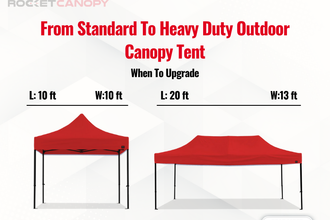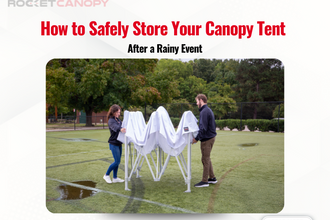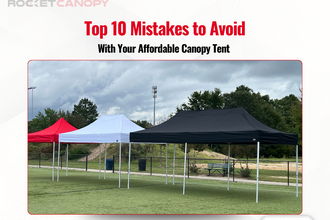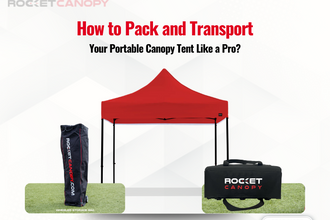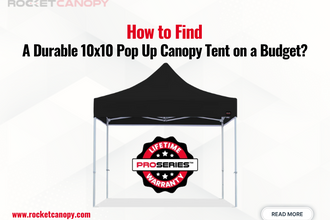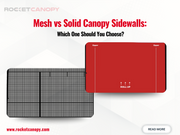
Mesh vs Solid Canopy Sidewalls: Features, Performance, and Event Uses
A pop-up canopy provides valuable overhead coverage, but it’s the sidewalls that transform it into a versatile, weather-ready space. By enclosing one or more sides, you can shield against wind, rain, and sun, keep insects out, add privacy, and even create a backdrop for branding. Sidewalls also help define your footprint at events, making your setup feel more professional and inviting.
Functionally, canopy sidewalls come in four common styles: door walls for easy access, window walls for light and visibility, half walls for open interaction, and solid walls for full coverage. Beyond style, material choice plays a major role in performance. The two most common options are mesh and solid polyester.
In this guide, we’ll break down the strengths and trade-offs of mesh and solid materials, show how each can work with different wall styles, and share practical tips to help you choose the best setup for your event conditions.
Table of Contents
- Why Choose Mesh Canopy Sidewalls
- How Mesh Canopy Sidewalls Improve Your Setup
- Potential Drawbacks of Mesh Canopy Sidewalls
- Why Choose Solid Pop-up Tent Walls
- What Solid Pop-up Tent Walls Do Best
- Potential Drawbacks of Solid Pop-up Tent Walls
- Mesh vs Solid Canopy Sidewalls: Side-by-Side Comparison
- How to Decide Between Mesh or Solid Pop-up Tent Walls
- Additional Tips for Using Any Canopy Sidewall
- Conclusion: Finding the Right Sidewalls for Every Event
- Frequently Asked Questions
Why Choose Mesh Canopy Sidewalls
Mesh canopy sidewalls are crafted from lightweight 100% polyester fabric with a breathable weave. They promote airflow while still providing a sense of enclosure and maintaining visibility. Offering protection from insects, these walls are also waterproof and fireproof, ensuring durability, safety, and reliable performance in a variety of weather conditions.

How Mesh Canopy Sidewalls Improve Your Setup
-
Improves airflow in hot or humid weather
Mesh sidewalls allow steady air circulation, helping your canopy stay cooler and more comfortable during warm conditions. This makes them a great fit for summer markets, festivals, or sports events where heat buildup can be a problem.
-
Keeps insects out without blocking the view
The fine mesh stops flies, mosquitoes, and other pests from entering while maintaining visibility and customer interaction. It’s especially useful for evening food fairs, farmers’ markets, or waterfront gatherings
-
Reduces wind strain on the canopy
By letting some wind pass through, the mesh canopy sidewalls limit the “sail effect” and lower stress on the frame. This feature is valuable in coastal areas, open fields, beach events where gusts are common
Potential Drawbacks of Mesh Canopy Sidewalls
Mesh canopy sidewalls are versatile, but they’re not the best fit for every situation. Here are a few limitations to keep in mind when deciding if mesh is right for your setup:
-
Offers less privacy than solid walls
Because mesh is see-through, anyone outside the canopy can still see inside. This is fine for open markets and public events but not ideal for private gatherings, secure storage areas, or changing spaces.
-
Limited protection against wind and heavy rain
The breathable weave allows some wind, dust, and rain to pass through. While mesh holds up well in mild conditions, solid waterproof panels offer better protection for high-stress environments or unpredictable weather.
For events where weather and wind are unpredictable, it’s important to know how to choose a pop-up tent for a high-stress environment so your setup is built to handle the pressure.
For events where airflow isn’t the priority and stronger protection is needed, solid canopy sidewalls offer a different set of advantages.
Why Choose Solid Pop-up Tent Walls
Solid canopy sidewalls are full fabric panels, typically water-resistant or waterproof polyester. They create a complete enclosure that blocks wind, rain, and sun, adds privacy, and provides a professional backdrop for event branding.

What Solid Pop-up Tent Walls Do Best
Solid canopy sidewalls offer maximum coverage and weather protection, making them a reliable choice for events that demand privacy, branding space, and dependable shelter.
-
Creates complete privacy and a large space for branding
Solid panels block outside views, making them ideal for private meetings, secure storage, or VIP areas. The uninterrupted fabric also works as a large surface for logos, graphics, or signage—perfect for corporate events or promotional use.
-
Provides stronger protection from wind, rain, and sun
A solid pop-up tent wall acts as a barrier against harsh weather, helping keep interiors dry and sheltered during outdoor events.
-
Helps manage interior temperature in cooler conditions
Solid canopy walls retain warmth and block direct sunlight when needed, making it suitable for events across different seasons.
Potential Drawbacks of Solid Pop-up Tent Walls
Solid canopy sidewalls deliver dependable coverage, but they’re not the right fit for every situation. Here are a few considerations before choosing them for your setup:
-
Reduced airflow in warm or humid weather
Since solid walls block ventilation, the inside of the canopy can get stuffy and uncomfortable in hot conditions. Using fans, opening one side, or combining solid and mesh panels or different wall types can help improve comfort.
-
Can catch wind like a sail if not properly secured
In strong winds, solid walls can trap air, putting extra strain on your canopy frame and anchors. Proper tie-down kits and weighted bases are essential to maintain stability.
For stability tips, read What Are the Best Ways to Keep Your Large Canopy Tent Stable
To make the differences clearer, here’s a quick side-by-side comparison of mesh and solid options.
Mesh Canopy Sidewalls vs Solid Canopy Sidewalls
Both mesh and solid canopy sidewalls have clear strengths, and the right choice depends on your event’s location, weather, and privacy needs. To help you compare at a glance, here’s how they stack up side by side:
| Feature | Mesh Sidewalls | Solid Sidewalls |
|---|---|---|
| Airflow & Ventilation | Excellent | Limited |
| Weather Protection | Light rain & mild wind only | Stronger rain, wind & UV protection |
| Privacy | Low | High |
| Branding Potential | Limited | Excellent (large printable surface) |
How to Decide Between Mesh or Solid Pop-up Tent Walls
Choosing the right sidewall comes down to your event type, environment, and performance needs.
- Event Type: Public markets and casual sports events often benefit from mesh for openness, while corporate functions may prefer solid panels for branding and privacy.
- Weather Conditions: Mesh is ideal for summer heat; solid works best in rainy, windy, or cold seasons.
- Privacy Needs: Mesh allows open interaction; solid provides an enclosed space.
- Setup Location: Indoor setups may lean toward solid for branding, while outdoor events in hot weather may favor mesh.
Some setups use a hybrid approach , mesh on some sides for airflow, solid on others for privacy and weather protection. This hybrid approach is often the most flexible for year-round use. Beyond choosing the right wall type, here are some practical tips for using and maintaining any sidewall.
Additional Tips for Using Any Canopy Sidewall
-
Prioritize Stability
Always anchor and secure sidewalls properly to prevent wind from pulling or damaging them. Use weight plates, tie-down straps, or ground stakes depending on the setup location.
-
Storage & Transport
Invest in durable tent wall storage bags or hard cases to protect walls from dirt, moisture, and abrasions. Proper storage extends fabric life and keeps walls event-ready.
-
Mix and Match
Keep both mesh and solid sidewalls in your inventory so you can adapt to different seasons and event conditions.
Find the Right Sidewalls for Every Event
The choice between mesh and solid canopy sidewalls comes down to balancing airflow, weather protection, privacy, and branding potential. Mesh sidewalls excel in warm climates, outdoor markets, and open events where ventilation and visibility matter most. Solid sidewalls shine in unpredictable weather, private setups, or corporate events that call for a clean, branded backdrop.
Many professionals keep both on hand, swapping or combining them to match the season and location. Whatever your setup calls for, Rocket Canopy walls (in sizes 10ft and 15ft) are built for a perfect fit and lasting performance—available in mesh, solid, and compatible with our commercial-grade canopy frames.
Shop our full range of mesh and solid canopy sidewalls to find the perfect fit for your Rocket Canopy frame—built for durability, performance, and year-round us
Frequently Asked Questions
Do sidewalls prevent wind from blowing canopy?
Yes, but with conditions. Solid sidewalls block wind, which can make the interior more comfortable, but they can also catch wind like a sail, putting strain on the frame if not anchored well. Mesh sidewalls reduce the “sail effect” by letting some wind pass through, which improves stability in gusty areas. Always use proper anchors or canopy weight plates for stability.
Where can I buy mesh or solid canopy sidewalls?
You can shop Rocket Canopy sidewalls designed for a perfect fit with our commercial-grade frames. We offer both mesh and solid options, built from heavy-duty, weather-resistant fabric for reliable performance.
What is the strongest material for a wall?
For pop-up tent sidewalls, heavy-duty polyester with a high denier rating (500D–1000D) and a PVC or polyurethane coating is considered the most durable.
Can I use different types of sidewalls on the same canopy?
Yes. Mixing mesh and solid panels is a common approach, placing mesh walls on sun-facing or high-traffic sides for ventilation and visibility, and solid walls on other sides for weather protection and privacy. This hybrid setup maximizes comfort and versatility.

